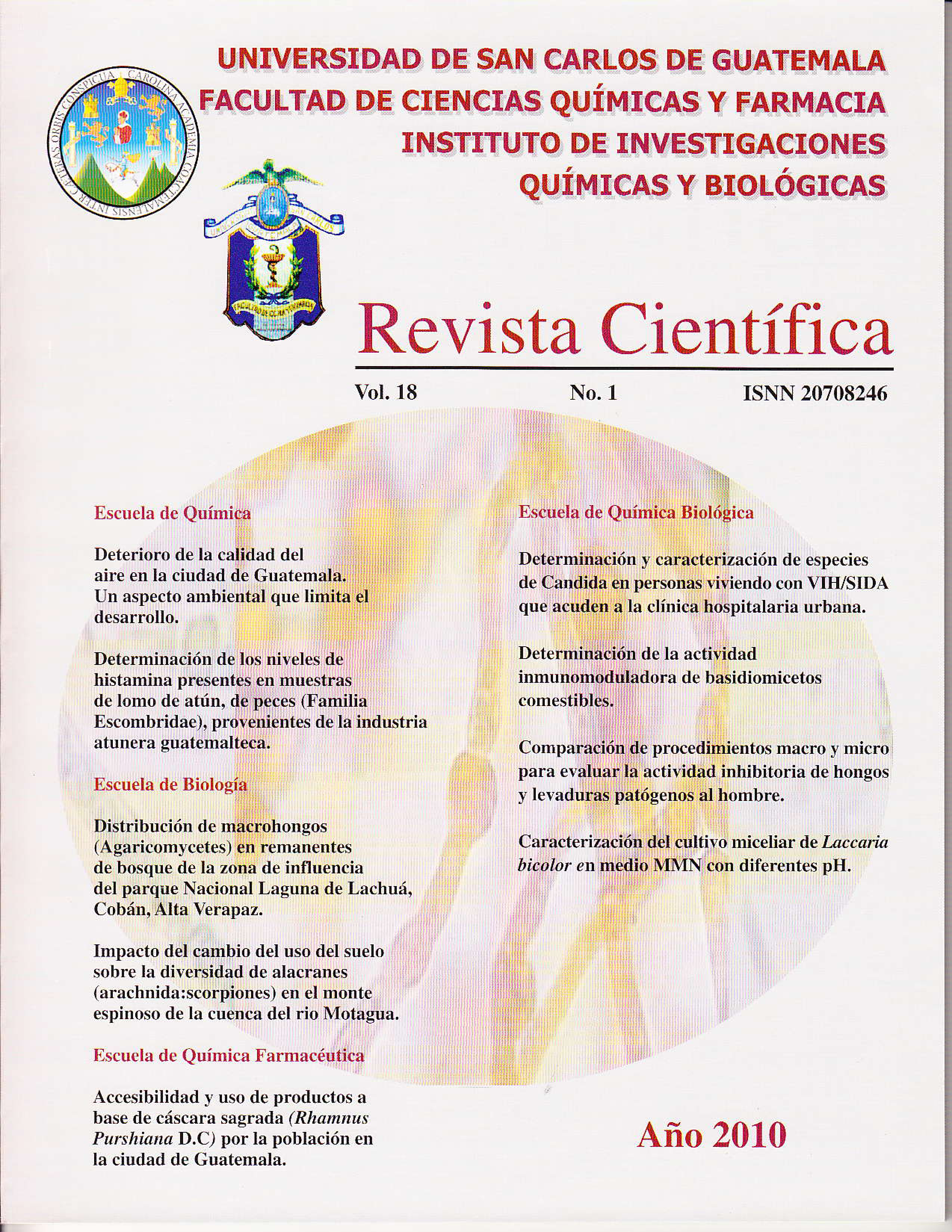Chemical characterization and evaluation of the biological activity of bourreria huanita (llave & lex.) hemsl. (Esquisuchil or brother Pedro's tree)
DOI:
https://doi.org/10.54495/Rev.Cientifica.v18i1.171Keywords:
Bourreria Huanita, Esquisuchil, Brother Pedro's TreeAbstract
The extraordinary plant biodiversity of the region and the limited existing scientific technical information on native flora suggest the need to conduct studies on poorly studied plant species that are attributed medicinal properties. A particular case is that of esquisuchil (Bourreria huaiiita), a Boraginaceae recognized in Mesoamerica for its medicinal properties since pre-Hispanic times. Commonly used in a traditional and popular way for its antimicrobial and anti-inflammatory effect of the flower infusion, to cure bacterial or viral skin lesions, for fever, as a tranquilizer and anxiolytic, in heart disease, blood pressure, used as a disinfectant choline, relieves menstrual pain and anti-abortion, and is also attributed analgesic and anticancer properties. According to the review carried out, there is no information on its chemistry and biological activity, so the characterization through chemical and biological assays of plant extracts and essential oils of the flower was carried out. The sample was collected in Antigua Guatemala, identified by a botanist and morphoanatomical, organoleptic and physicochemical tests were performed to evaluate the quality and purity of the plant drug. The total solids test was performed to select the best solvent, resulting in 50% ethanol with an extract yield of 38.1%. The essential oil was extracted by hydrodistillation using a Neoclevenger type apparatus, presenting 30 constituents, the majority being farnesyl ketone (8.38%), 2OH-phenylene benzoic acid (8.37%), ≤ phenylethylsalicylate (5.60%), 6,10 dimethyl 2-undecanone (5.29%) and heneicosane (5.20%), which could be of interest in the food industry. Liquid-liquid partitions were performed from the crude ethanolic extract using solvents of different polarities (hexane, chloroform, and ethyl acetate). The partition with the highest yield was hexane (4.0%). Phytochemical screening revealed that the secondary metabolites present in B. huanita were: alkaloids, flavonoids and anthocyanins, tannins, and coumarins. According to phytochemical screening, the secondary metabolites present in ethanolic extracts were: flavonoids and anthocyanins, sesquiterpene lactones, steroids and triterpenoids, tannins, coumarins, saponins, and volatile oils. In dichloromethane extracts, the metabolites detected were steroids and triterpenoids, coumarins, and volatile oils. Biological activity was assessed, revealing that the ethanolic extract exhibited antibacterial activity against E. co/i at 0.5 mg/mL. None of the plant extracts tested showed antifungal, cytotoxic, or larvicidal activity. We hope to establish contact with other research centers to conduct pharmacological tests on the nervous system.
Downloads
References
Brancato, FP. y Golding, NS. 1953. The diameter of the mould colony as a reliable measure of growth. Mycologia 45:848-864, https://doi.org/10.1080/00275514.1953.12024321
Cáceres, A. 1996. Plantas de Uso Medicinal en Guatemala. Editorial Universitaria. Guatemala.
European Pharmacopoeia. 2001 . 4’h Edition and supplements. Strasbourg: Conseil de L‘ Europe.
Mishra, S.K. et al. 1987. Insecticidal and nematicidal properties of microbial metabolites. J Indust Microbiol 2:267-276. https://doi.org/10.1007/BF01569429
Mitscher. L.A. el al. 1 972. Antimicrobial agents from higher plants. 1. Introduction rationale and methodology. Lloydia 35:157-166, https://doi.org/10.1007/BF01569429
Ortiz, H. 2006. Actividad antifúngica de los extractos ctanólicos de la flor de Boarreria huamra y la hoja de Lippia yraveolens y sus particiones hexánica, elorofórniiea, acetato de etilo y acuosa contra los hongos Sporothríx schenckii y Fonsecae pedrosoi. Tesis de Química Biológica. Universidad de San Carlos de Guatemala. 70 p.
Sharapin, N. 2000. Fundamentos de Tecnología de Productos Fitoterapéuticos. Santafé de Bogotá: Convenio Andrés Bello y CYTED. 247 p.
Solis, P. Guerrero, N., Gatusso, S., Cáceres. A. 2005. Manual de Caracterización y Análisis de Drogas Vegetales y Productos Fitoterapéuticos. Proyecto de Desarrollo de Tecnología de Cultivo de Plantas Medicinales y Producción de Fitoterápicos. Organización de los Estados Americanos y la Agencia Interamericana de Cooperación para el Desarrollo. OEA/AICD/AE089/03. 132p.
Solis, P.N. et al. 1993. A microwell citotoxicity assay using Artemia salina (Brine shrimp). Planta Med. 59:250-252, https://doi.org/10.1055/s-2006-959661
Standley. P.C. & Steyermark J.A. 1946. Flora of Guatemala. Fiediana: Botany 24(4): 315. https://doi.org/10.5962/bhl.title.2233
Torres, M.E 2002. El Esquisúchil, Árbol del Hermano Pedro. Folleto ilustrado Excelgrafic. Santa Lucía Milpas Altas. Sacatepéquez, Publicado por la Iglesia San Francisco El Grande, La Antigua Guatemala: y Tras las Huellas del Hermano Pedro de Betancur. Guía del Peregrino. Suplemento ordinario de la Revista Galería:1 (2), Fundación G&T, Guatemala.
Wagner. H . & Bladt, S . 1996. Plant Drug Análisis. Springer Verlag. Berlin. 320 p, https://doi.org/10.1007/978-3-642-00574-9
WHO . 1998. Quality control methods for medicinal plant materials. Geneva: WHO. 115 p.
Downloads
Published
How to Cite
Issue
Section
License
Copyright (c) 2010 S.M. Cruz, E.P. García, H. Letrán, I. Gaitán, B. Medinilla, R. Orozco, M.C. Samayoa, A. Cáceres

This work is licensed under a Creative Commons Attribution 4.0 International License.
Authors who publish with this journal agree to the following terms:
- Authors retain copyright and grant the journal right of first publication with the work simultaneously licensed under a Creative Commons Attribution License 4.0 that allows others to share the work with an acknowledgement of the work's authorship and initial publication in this journal.
- Authors are able to enter into separate, additional contractual arrangements for the non-exclusive distribution of the journal's published version of the work (e.g., post it to an institutional repository or publish it in a book), with an acknowledgement of its initial publication in this journal.
- Authors are permitted and encouraged to post their work online (e.g., in institutional repositories or on their website) prior to and during the submission process, as it can lead to productive exchanges, as well as earlier and greater citation of published work.









